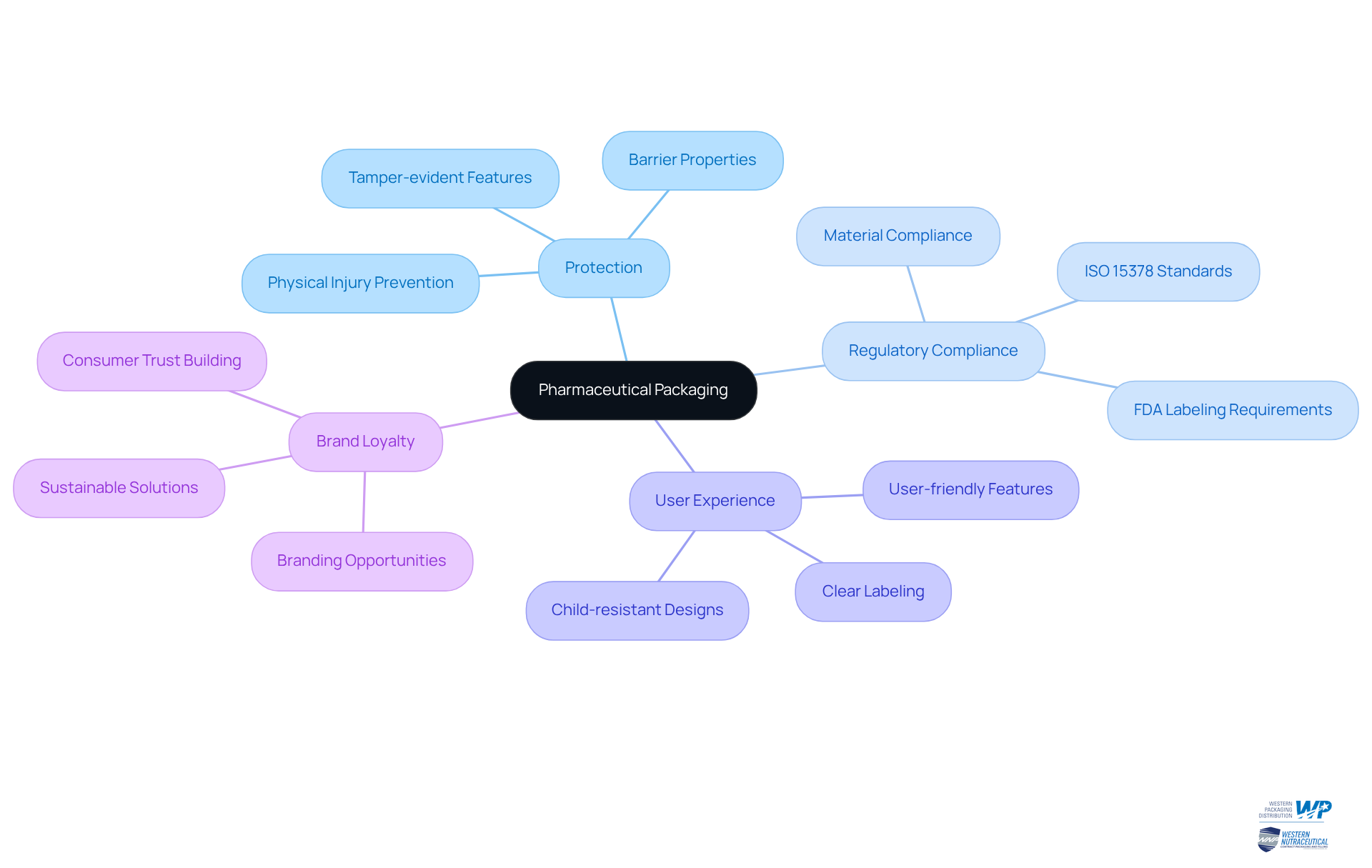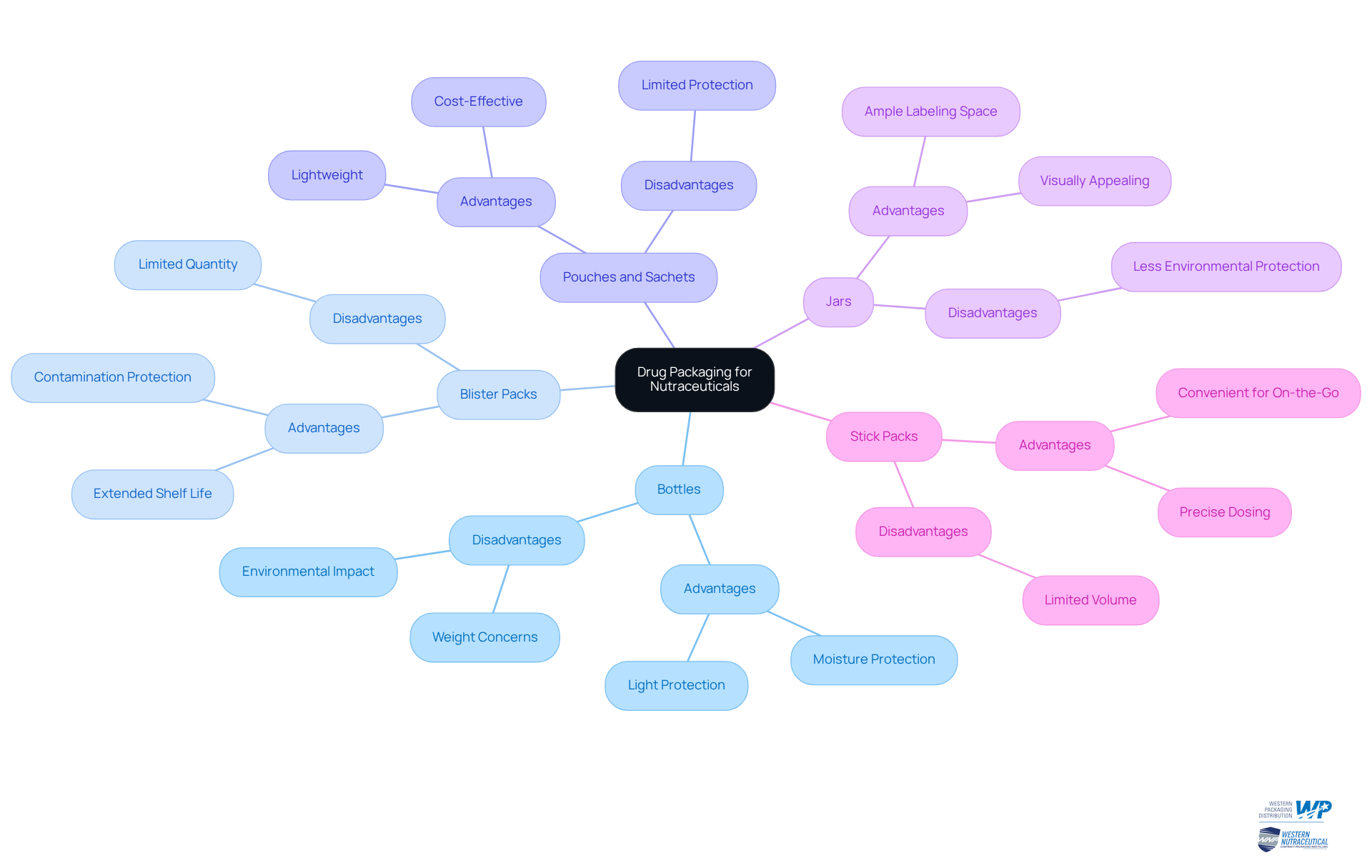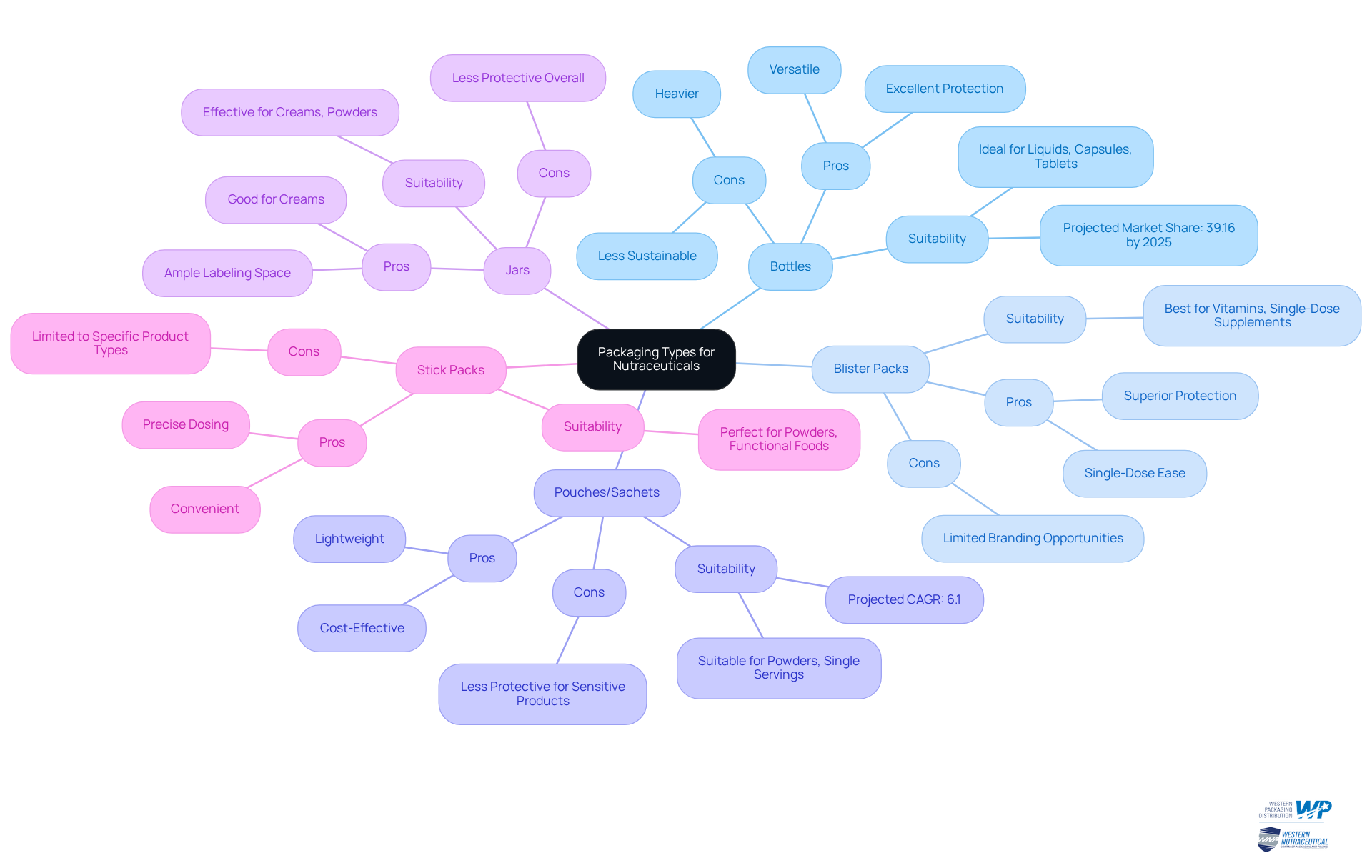Overview
This article provides a comprehensive comparison of various drug packaging types for nutraceuticals, detailing the advantages and disadvantages of each to assist manufacturers in selecting the most appropriate option. By understanding these packaging types—such as bottles, blister packs, pouches, jars, and stick packs—producers can effectively balance critical factors such as:
- Product protection
- Regulatory compliance
- User experience
- Branding opportunities
- Sustainability
This knowledge ultimately enhances market appeal, positioning manufacturers for success in a competitive landscape.
Introduction
Understanding the intricacies of drug packaging is essential in the nutraceutical industry, where the right container can significantly influence product integrity and consumer trust. As manufacturers navigate a landscape filled with diverse packaging options—from bottles and blister packs to pouches and jars—each choice presents unique advantages and challenges. These factors can profoundly impact brand perception and compliance with regulatory standards.
How can producers effectively balance functionality, sustainability, and consumer appeal to select the most suitable packaging type for their products?
This article delves into the various drug packaging types available for nutraceuticals, providing insights that empower manufacturers to make informed decisions in a rapidly evolving market.
Understand Pharmaceutical Packaging: Key Concepts and Importance
Pharmaceutical containers are pivotal in safeguarding nutraceutical items from environmental factors, ensuring adherence to regulatory standards, and enhancing user experience. The primary container directly houses the product, while the outer layer offers added protection and branding opportunities. Efficient wrapping not only preserves the quality of nutraceuticals but also significantly influences consumer perception and brand loyalty.
For instance, the integration of tamper-evident features and clear labeling is essential for building trust among consumers, particularly in the nutraceutical sector where safety is of utmost importance. Recent trends reveal an increasing focus on compliance with standards such as ISO 15378, which governs materials that come into direct contact with pharmaceuticals.
Grasping these fundamental concepts is vital for manufacturers aiming to refine their packaging strategies and effectively respond to market demands, especially as the industry progresses toward more sustainable and user-friendly solutions.

Explore Different Types of Drug Packaging for Nutraceuticals
Nutraceuticals can be offered in different drug packaging types, each providing distinct advantages tailored to specific applications. The most common types include:
-
Bottles: Typically crafted from glass or plastic, bottles are versatile and suitable for liquids, capsules, and tablets. They offer effective safeguarding against moisture and light, which is essential for preserving integrity. However, their weight and environmental impact can be concerns for sustainability-focused brands.
-
Blister Packs: Ideal for single-dose applications, blister packs excel in safeguarding against contamination and extending shelf life. Their convenience renders them especially favored for vitamins and supplements, enabling individuals to effortlessly obtain individual doses while guaranteeing product safety.
-
Pouches and Sachets: These flexible packaging options are lightweight and cost-effective, making them suitable for powders and single servings. Pouches and sachets also enable easy branding and shopper engagement, appealing to health-conscious individuals seeking convenience.
-
Jars: Often utilized for creams and powders, jars offer ample space for labeling and branding. While they provide a visually appealing presentation, they may not deliver the same level of protection against environmental factors as other formats.
-
Stick Packs: Gaining traction for their convenience, stick packs are perfect for on-the-go consumers, allowing for precise dosing. They are commonly used for powdered supplements and functional foods, catering to the increasing demand for portable health solutions.
Every drug packaging type offers its own advantages and disadvantages, making it crucial for producers to choose the most suitable format based on item features and target audience preferences. With the nutraceutical container market anticipated to achieve USD 6.95 billion by 2030, comprehending these choices is essential for enhancing item appeal and compliance.

Evaluate Comparison Criteria: Choosing the Right Packaging for Your Needs
When selecting packaging for nutraceuticals, several criteria warrant careful consideration:
-
Product Protection: The packaging must effectively safeguard the product from environmental factors such as moisture, light, and air, which can degrade active ingredients. Utilizing high-barrier materials is essential to maintain effectiveness and extend shelf life.
-
Regulatory Compliance: It is imperative that packaging complies with FDA regulations and labeling requirements, ensuring that all essential information is clearly displayed to purchasers. As noted by Sara Lesina, maintaining pharmaceutical-grade quality is crucial for compliance and integrity.
-
User Experience: The ease with which packaging can be opened, used, and stored significantly impacts consumer satisfaction and repeat purchases. Attributes such as child-resistant closures are required for specific items, enhancing usability and safety.
-
Branding Opportunities: Packaging design should reflect the brand's identity and values, enhancing visibility and appeal on retail shelves. Creative designs can capture interest and distinguish products in a competitive environment.
-
Sustainability: With growing public awareness of environmental concerns, selecting sustainable materials can improve brand reputation and attract eco-conscious buyers. As emphasized by Balaji Jayaseelan, focusing on material circularity and including compostable choices aligns with industry trends and consumer preferences.
By thoroughly assessing container options based on these standards, manufacturers can identify the most suitable solutions for their nutraceutical offerings, effectively balancing functionality with consumer attraction.

Compare Packaging Types: Pros, Cons, and Suitability for Nutraceuticals
Packaging Type Comparison:
-
Bottles
- Pros: Versatile, excellent protection
- Cons: Heavier, less sustainable
- Suitability: Ideal for liquids, capsules, tablets; projected to capture 39.16% of the market share by 2025
-
Blister Packs
- Pros: Superior protection, single-dose ease
- Cons: Limited branding opportunities
- Suitability: Best for vitamins, single-dose supplements
-
Pouches/Sachets
- Pros: Lightweight, cost-effective
- Cons: Less protective for sensitive products
- Suitability: Suitable for powders, single servings; projected to grow at a CAGR of 6.1% during the forecast period
-
Jars
- Pros: Ample labeling space, good for creams
- Cons: Less protective overall
- Suitability: Effective for creams, powders
-
Stick Packs
- Pros: Convenient, precise dosing
- Cons: Limited to specific product types
- Suitability: Perfect for powders, functional foods
This comparison elucidates the strengths and weaknesses of each packaging type, enabling manufacturers to make informed choices tailored to their product specifications and target demographics. For instance, while blister packs excel in providing single-dose convenience, they may fall short in branding potential. Conversely, pouches offer flexibility and cost-effectiveness but may lack the necessary protection for sensitive ingredients. Understanding these elements empowers producers to refine their strategies regarding drug packaging types, ultimately enhancing product appeal and market visibility.
Market trends indicate that bottles and jars dominate the nutraceutical container landscape, with bottles projected to secure 39.16% of the market share by 2025. Furthermore, the growing preference for flexible packaging solutions signifies a shift towards safeguarding products from environmental threats such as oxidation and moisture. As sustainability remains a pivotal trend, manufacturers are increasingly exploring biodegradable and recyclable materials to align with consumer expectations and regulatory standards.

Conclusion
Selecting the right packaging for nutraceuticals is essential for ensuring product integrity, compliance, and consumer satisfaction. The various types of drug packaging—bottles, blister packs, pouches, jars, and stick packs—each come with unique benefits and challenges that can significantly impact both the product's shelf life and its appeal to consumers. Understanding these differences allows manufacturers to make informed decisions that align with their brand values and market demands.
Throughout this article, critical factors such as:
- Product protection
- Regulatory compliance
- User experience
- Branding opportunities
- Sustainability
have been highlighted as vital considerations when choosing packaging. Each packaging type has been evaluated for its suitability based on these criteria, revealing that while some options excel in convenience and protection, others may offer better branding potential or sustainability.
Ultimately, the choice of packaging is not merely a logistical decision but a strategic one that can influence market success. As the nutraceutical industry continues to evolve, embracing innovative and sustainable packaging solutions will not only enhance product appeal but also foster consumer loyalty in an increasingly competitive landscape. Manufacturers are encouraged to assess their packaging strategies carefully, ensuring they meet both regulatory standards and the growing expectations of health-conscious consumers.
Frequently Asked Questions
What is the primary function of pharmaceutical packaging?
The primary function of pharmaceutical packaging is to safeguard nutraceutical items from environmental factors, ensure adherence to regulatory standards, and enhance user experience.
What are the two main components of pharmaceutical containers?
The two main components of pharmaceutical containers are the primary container, which directly houses the product, and the outer layer, which provides added protection and branding opportunities.
How does efficient wrapping impact consumer perception?
Efficient wrapping preserves the quality of nutraceuticals and significantly influences consumer perception and brand loyalty.
Why are tamper-evident features important in pharmaceutical packaging?
Tamper-evident features are essential for building trust among consumers, especially in the nutraceutical sector where safety is a top priority.
What regulatory standard is mentioned in relation to pharmaceutical packaging?
The regulatory standard mentioned is ISO 15378, which governs materials that come into direct contact with pharmaceuticals.
Why is it important for manufacturers to understand pharmaceutical packaging concepts?
It is important for manufacturers to understand these concepts to refine their packaging strategies and effectively respond to market demands, particularly as the industry moves toward more sustainable and user-friendly solutions.




